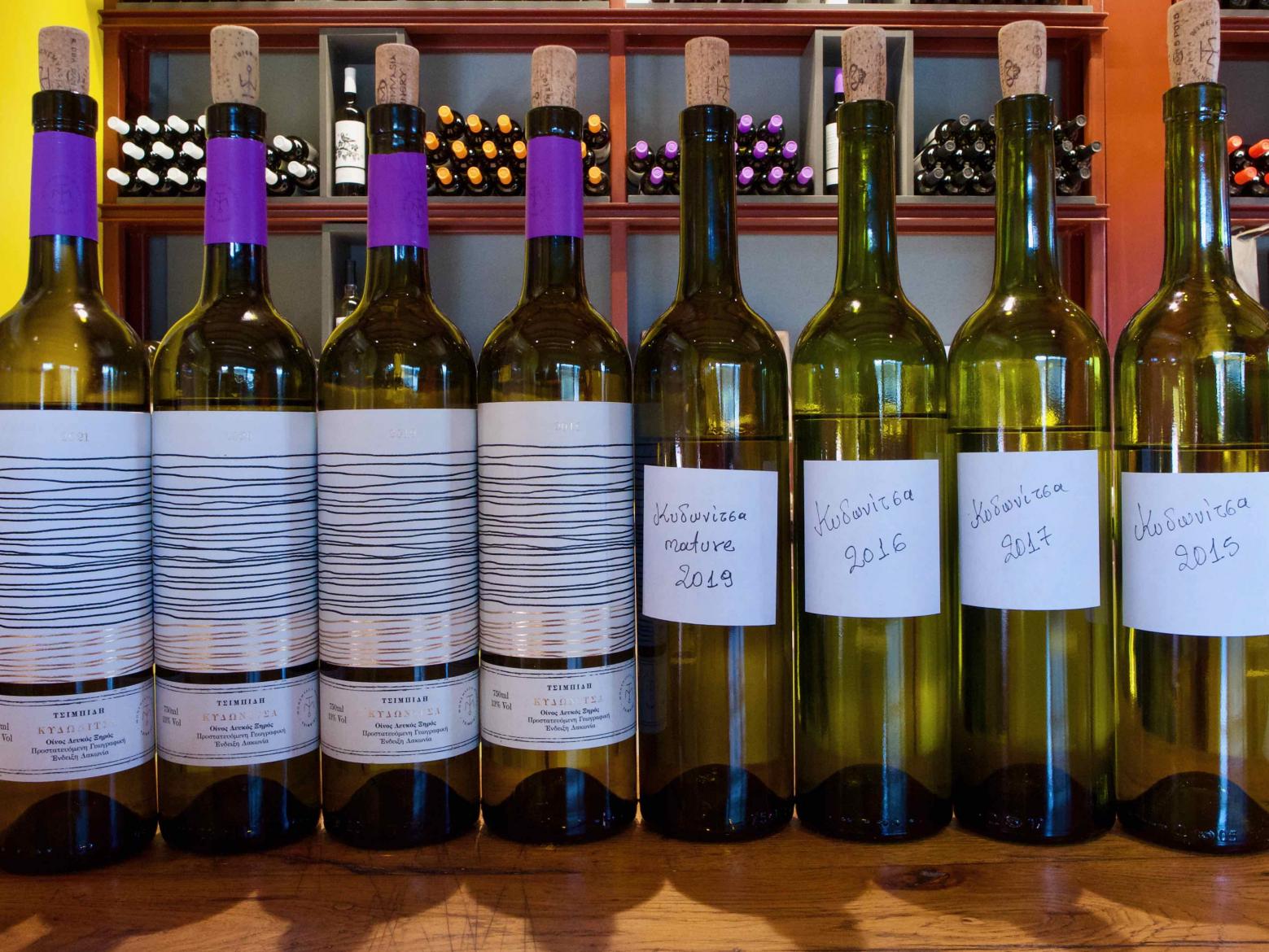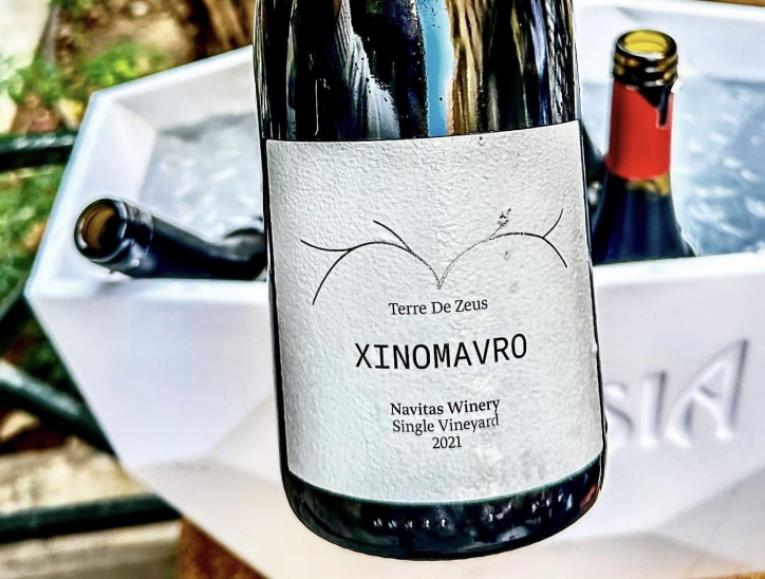Monemvasia Winery and a Kidonitsa vertical
By Olga Antoniadou
I first visited Monemvasia Winery in 2015 when it was still housed in its old premises, just a short distance from where the new winery has been built, a mere 10km from the Fort of Monemvasia in Lakonia, Peloponnese. The new winery, not quite complete, has been designed to have space for everything necessary, together with offices, a lab, and room for wine-tasting events. Elli and George Tsimbidis were both into education. Elli, a primary school teacher (actually Andreas Andresakis, the oenologist, is her ex-pupil), and George taught Physics. George dreamed of returning to his homeland. I can see why. The landscape in Lakonia is stunning. It has an austerity and ruggedness that makes you shudder. No wonder the ancient Spartans were unforgiving warriors. Elli says, "I was introduced to George by friends, and after some time, he brought me down here to show me the place. I knew right then that this was where I wanted to make my home. Long before we decided to marry".
We were greeted by Elli and Marialena, their eldest daughter, who is part of the team at the winery. She was still a student when we initially visited. Her studies were in agricultural science and food technology, with studies in oenology. Her younger sister Anastasia, also part of the team, studied chemistry with a master's degree in oenology. They have a younger sister on the way, who is also studying oenology. Quite a team. I was very impressed with Marialena. Informed, warm, engaging, and straightforward, this lovely young lady kept us company for the whole tasting she headed and the round of the winery and grounds. Marialena and Anastasia have spent a lot of time re-designing the labels of their wines in collaboration with a graphic art designer, and they have managed to give the labels a clean-cut and modern take. An extra perk during our visit was the amazing artwork of Rolandina, a 9-yr old genius, on exhibition at the winery.
Elli and George I liked, from the first time I met them. I always like people who dream and do everything in their power to materialise their dream. They had a vision of reproducing the famous Malvasia wine of the Middle Ages. After years of pouring over old documents and help from the Greek Wine Institute, the Agricultural University of Athens, the Division of Plant Pathology of the Agricultural University of Thessaloniki and the Plant Virus Lab of Heraklion, Crete, they managed to produce their sweet Malvasia wine, as close a replica as we can know.
They own 30ha of land farmed organically and planted mainly with indigenous varieties like Kidonitsa, Asproudi and Mavroudi. The winery was founded in 1997.
I had asked them for a vertical tasting of Kidonitsa. Kidonitsa aromatically shows quince notes, accompanied by orange, bergamot, and pear, with some minerality and notes of chamomile flowers. On the palate, the wines produced are crisp and medium-bodied with medium alcohol. A thick-skinned, mid-ripening variety that can sometimes have a tannic bite.
I tasted 2022-2015. Classic white wine fermentation in temperature-controlled tanks with cultured yeast, with 5-6 months on the lees in the tank for all the following wines. As of 2019, smaller 5-ton tanks have been bought to ferment individual parcels, the wines from which are subsequently blended. I was pleasantly surprised by the evolution over time and, once again, confirmed in my mind that many of the Greek white wines are drunk too young and fresh. It was also evident during the tasting that the quince notes associated with the variety developed after a couple of years.
2022 tank sample: Very aromatic, with mainly aromas of apple, pear and tropical fruit like melon and ripe pineapple, some ripe citrus fruit aromas, medium alcohol at 13% abv, fresh acidity and a citrusy longish finish. Very interesting, but I couldn't tell that this was Kidonitsa. Too fresh. I would definitely give it a five-year ageing potential.
2021: Aromas of citrus fruit like lemon and grapefruit and a floral/herbal note reminded me of pelargonium graveolens (rose-scented geranium). Again medium alcohol, medium body with the refreshing acidity, altogether more typical of the variety. This a very good example. Again, it needs more time to develop its fingerprint.
2020: Mainly aromas and flavours of citrus fruits on the nose and the palate. Fresh acidity and a lemony finish. A delicious wine.
2019: Aromas of citrus fruits, chamomile flowers and lemongrass on the nose, notably citrusy on the palate, crisp, of medium alcohol and body and a longish finish. A very good wine that shows a balance of fruit, acidity and structure.
2018: This wine was the best wine of the tasting. Apart from the citrus fruit, floral aromas, aromas of asparagus, and more earthy mushroom notes together with a quincy blast and a mineral, wet stone finish. A fascinating wine. I was told that this was an excellent vintage, with some rain in June which helped grape development.
2017: Aromas of ripe, sweet quince in the forefront, wet wool minerality, a tannic bite, more backbone and structure, the acidity subdued. Also, an exciting wine which reminded me of an aged Chenin Blanc.
2016: A scorching year that led to a super early harvest. Slightly oxidative on the nose, with aromas of sweet oranges, ripe red apples and quince paste. A wine that needs to be drunk now.
2015: Again, aromas of dried red apples, quince paste, and a slight floral/herbal note, with notes of biscuits and toffee. Again a wine with backbone and structure, crisp and more oxidative characteristics. Initially, I thought it was on its drinking age limit, but when I returned to the wine after some time, I found the sweet, honey-toffee character particularly pleasant.
An extra mention to an experimental Kidonitsa wine of 2019 (mature) with pre-fermentation soaking on the skins at 10oC for 15-16 hours from a particular vineyard site named Velios. Sweeter tasting, structured from the tannins and acidity, bolder aromatics with a long finish. A different take on the wine, which I found has potential—a food wine.




